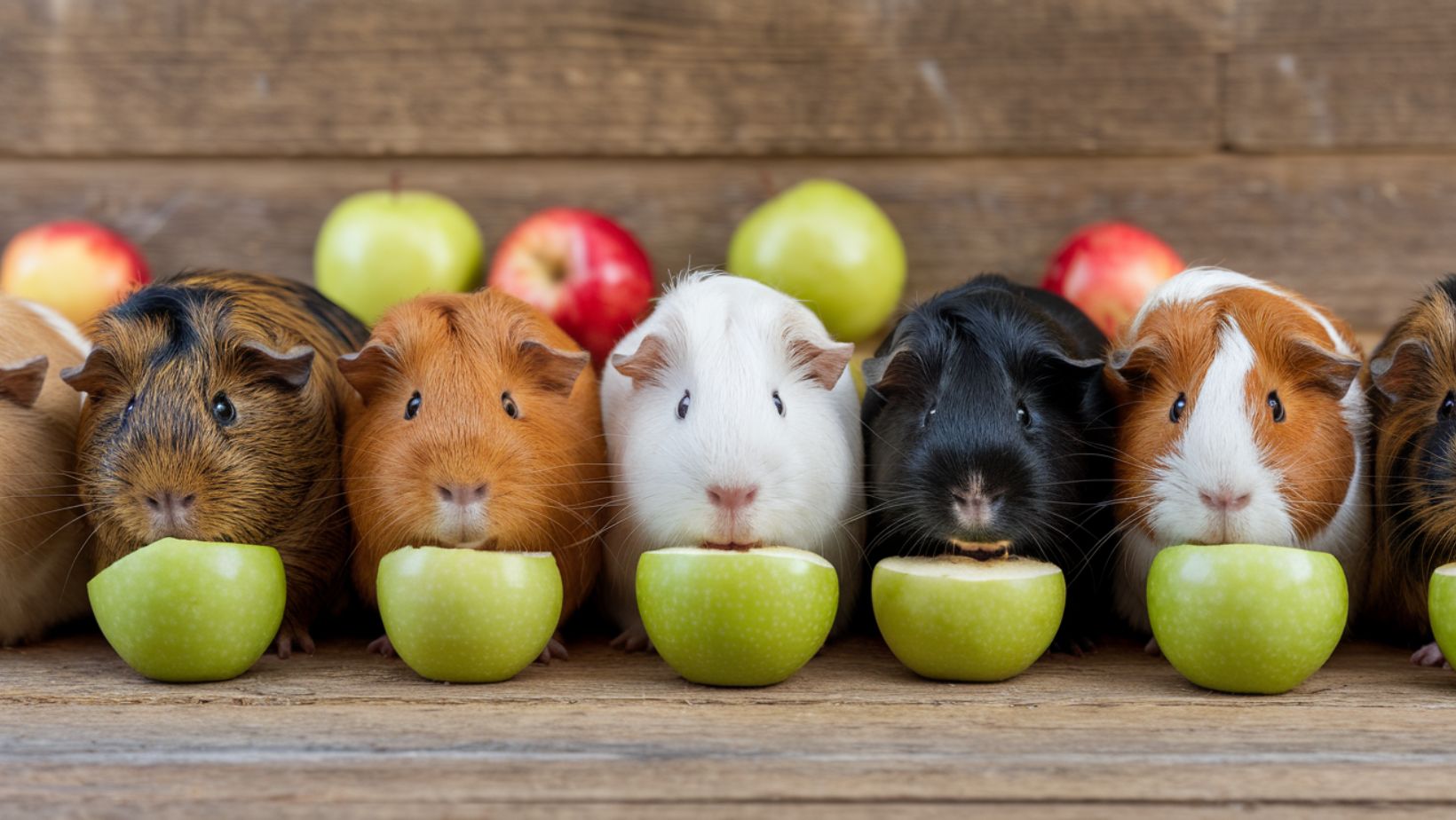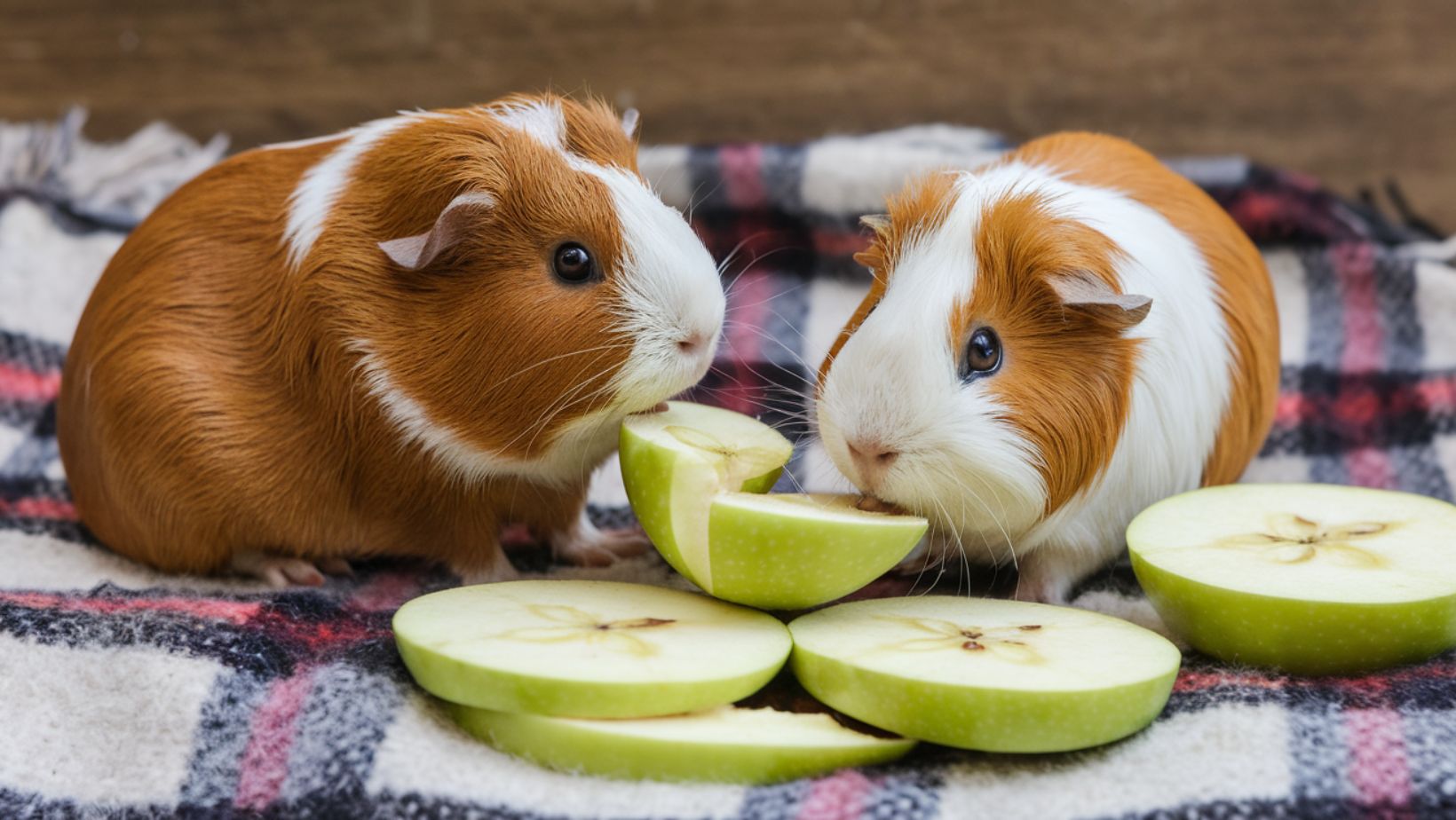When it comes to feeding our furry friends, it’s crucial to understand what foods are safe and beneficial for their health. Guinea pigs have specific dietary needs, and while they primarily require hay and fresh vegetables, many pet owners wonder about fruits like apples as occasional treats.
Yes, guinea pigs can safely eat apples: “Apples are safe treats when served properly and in moderation”
Guinea pigs can indeed eat apples, and they often enjoy them as treats. However, this fruit should only be offered in moderation, typically 1-2 small pieces (about the size of a thumb) once or twice a week.
The key to safely feeding apples to your guinea pig lies in proper preparation and portion control. Always remove the seeds and core, as apple seeds contain small amounts of cyanide which can be harmful. The skin can remain if the apple is thoroughly washed to remove any pesticides or chemicals. It’s essential to introduce apples gradually into your pet’s diet and observe their reaction, as some guinea pigs may have individual sensitivities.
Your guinea pig can enjoy these sweet treats!
The simple answer is yes – guinea pigs can safely eat apples! These sweet, crunchy treats often become a favorite snack for many piggies. While apples make for an excellent treat, they should be served thoughtfully and in moderation.
Just like us enjoying a piece of cake, apples should be considered a special treat rather than a dietary staple for your guinea pig. The natural sweetness and crisp texture make them particularly appealing to most guinea pigs, but this same sweetness is why we need to be mindful of portions.
A tasty boost of vitamins for your little friend
Beyond being delicious, apples offer several nutritional benefits for your guinea pig. They’re a good source of vitamin C, which is essential since guinea pigs, like humans, can’t produce this vital nutrient on their own. Fresh apples also contain beneficial fiber and water content, contributing to your pet’s hydration and digestive health. The natural sugars provide a quick energy boost, which you might notice as your pig becomes more playful after enjoying their treat.
Watch those chompers grow happier
Guinea pigs’ teeth grow continuously throughout their lives, making proper dental wear crucial for their health. The crisp texture of fresh apple pieces provides natural help with dental maintenance. When your pig chews on apple pieces, it helps wear down their teeth naturally, though this shouldn’t replace their primary source of dental wear – hay. The chewing action also promotes healthy jaw exercise and can help prevent dental problems that might arise from overgrown teeth.
Serving up some apple joy: The perfect portion
When it comes to serving apples to your guinea pig, size really matters. A piece about the size of your thumb is plenty for one serving, and this should only be offered once or twice a week.
Before serving, always wash the apple thoroughly to remove any pesticides or chemicals. While the skin can stay on and provides additional nutrients, the seeds and core must always be removed as they contain compounds that could harm your pet. Cut the apple into small, manageable pieces to prevent any choking hazards and make it easier for your pet to enjoy.
Happy and healthy: Signs your pig loves their apple time
Proper apple portions can contribute to your guinea pig’s overall wellbeing. Many owners notice increased activity levels, maintained appetite for regular food, and even improvements in their pet’s coat condition.
However, these benefits only come with appropriate serving sizes and frequency. It’s important to observe your pet’s response to apple treats, especially when first introducing them. Some guinea pigs might show more sensitivity to fruits than others, which is perfectly normal.
Making treat time safe and enjoyable
The key to successful treat feeding lies in preparation and timing. Always serve apple pieces at room temperature, and only offer fresh, crisp pieces. Avoid giving old or browning apple pieces as these could cause digestive issues. Some owners find success in combining tiny apple pieces with regular vegetables as part of enrichment activities, making treat time both nutritious and mentally stimulating for their pets.
Understanding your pig’s special needs
Not all guinea pigs should have the same amount of apple treats. Overweight pigs, seniors, or those with health conditions might need modified portions or might need to avoid fruit treats altogether. Age, weight, and overall health should all factor into your decision about treat portions. Some guinea pigs might also have individual sensitivities that weren’t initially apparent, so always monitor their response to new treats carefully.
Building the perfect treat schedule
Treats like apples should make up no more than 10% of your guinea pig’s daily diet. The foundation of their nutrition should always be high-quality hay (about 80%), supplemented with fresh vegetables and a small amount of pellets. Consider apples as a weekend treat rather than an everyday food. This approach ensures your pig gets all the nutrition they need while still enjoying special treats safely.
Important limits to keep in mind
While apples can be a wonderful treat, there are several important limitations to remember. First, never exceed two small apple pieces per week, as too much sugar can lead to obesity and dental problems. Space out apple treats rather than giving them on consecutive days to prevent digestive issues. If you’re feeding other fruits as treats, make sure to count apple portions as part of the overall fruit allowance, not in addition to it.
Also, remember that baby guinea pigs should not have apple treats until they’re at least 6 months old and fully transitioned to adult food.
Seasonal considerations also play a role in treat feeding. During warmer months, the higher water content in apples can help with hydration, but be sure to remove any uneaten pieces promptly as they can spoil quickly in heat. In cooler months, maintain the same portion sizes even if your pig seems to want more – consistency is key for their digestive health.
By following these guidelines and paying attention to your pet’s individual needs and responses, you can safely make apple treats a delightful part of your guinea pig’s diet. Remember that every guinea pig is unique, so what works perfectly for one might need adjustment for another. The key is to observe, adjust, and always prioritize your pet’s overall health and happiness when it comes to treats.

